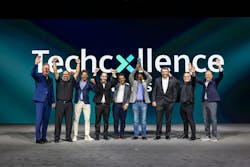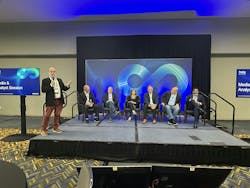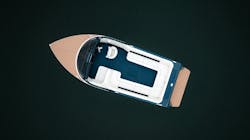Benchmarking Mechanical Design With AI-CAD Integration
A directive issued by the U.S. Department of Commerce’s Bureau of Industry and Security (BIS) to stymie sales of EDA (electronic design automation) tools directly to China was destined to be a talking point during a special panel held for media at the Siemens Realize Live Americas 2025 event in Detroit (June 2-5, 2025).
The topic was broached by an industry analyst, and the job of relaying Siemens’ position to trade media and analysts was assigned to Brenda Discher, SVP of Business Strategy and Marketing, Digital Industries Software, Siemens.
Siemens received the notification on May 23, 2025, and acted to “immediately turn off access to Siemens products in China,” explained Discher. “The requirement from the Bureau of Industry and Security, which is part of the Department of Commerce, is specific to certain export control classified products. It’s specifically certain products in EDA. We are still doing EDA business in China, but we cannot export some of our products...We have stopped delivering, supporting, issuing, licensing, etc., and technical support patches for those products. We are continuing with some of our PCB-related products.”
According to Discher, Siemens was actively engaging with both the U.S. and Chinese governments and hoped for a positive outcome. “Make no mistake, we are very committed to China,” said Discher. “We’re very committed to North America. We’ve been in China for more than 150 years. And if you look at the scope of Siemens’ footprint in China, this is not that big of a footprint for us.
“We waited to put a statement out, because China is extremely important to us,” she continued. “But we have stopped some of those products. We are evaluating. We are working with the U.S. government.” (Read the statement issued by Siemens here.)
On July 3, 2025, the United States lifted the restriction on exports to China for chip design software and Siemens was able to restore access to for its customers in China.
Fostering Better Communication with Design Tools
Discher’s nuanced response at that delicate moment was both practiced and impromptu. As head of communications, her reaction called for a deep understanding of her company’s objectives and an ability to respond appropriately to queries raised by a powerful audience on an issue that lays bare the innate fragility of the electronic design automation (EDA) market amidst geopolitical tariff and trade woes.
Discher’s proficiency is also ingrained. She has been with Siemens Digital Industries Software since 2018, holds a Bachelor of Science in mechanical/industrial engineering and a Master of Business Administration in international marketing and finance from Eastern Michigan University.
In the accompanying video interview with Machine Design, Discher unpacks industry trends, including the growing dependence on digital twins, AI and adaptive technologies, as well as how CAD/CAM/CAE offerings are evolving. An edited transcript of the interview follows below.
Machine Design: Which market trends are you watching closely?
Brenda Discher: I’m watching a couple of market trends. The first one is the change in manufacturing and the fact that manufacturing is moving more locally everywhere in the world. That requires a lot more investment and a lot more use of technology within the country where the manufacturing is happening, and as companies start to onshore or reshore their manufacturing.
As a result of that, the technology trends that people are embracing are things like digital twins, which allow them to quickly move into digital transformation. There isn’t a company in the world that doesn’t need to be more resilient, be able to get their products to market faster, and be able to figure out how to leverage their workforce in new ways to be more productive—and actually improve the productivity of not only their people, but their ecosystems.
READ MORE: Reverse Mic: NVIDIA, Teradyne Thought Leaders Compare Notes
From a technology standpoint, a couple of technologies, digital twins first and foremost, the second one is AI. It’s affecting everything. In fact, I love the quote our CEO, Tony Hemmelgarn, has been saying recently, which is we are probably the last managers that are going to be managing a workforce of just people. So, looking forward, we will have workforces where you manage humans and agents.
And then, the third trend that I’m watching is this idea of what I’m calling technology that is adaptive. So, technology that adapts with you or adapts products and adapts to the conditions or the experiences; there’s hardly a product in the world that doesn’t have software in it.
Those are the big trends for me.
There isn’t a company in the world that doesn’t need to be more resilient, be able to get their products to market faster, and be able to figure out how to leverage their workforce in new ways to be more productive—and actually improve the productivity of not only their people, but their ecosystems.
MD: Which trends would you say are not getting enough attention?
BD: What I hear most when I talk to our customers—and the folks that are probably your particular audience—is, how do we capture the knowledge of today’s workforce, as that workforce in the next three to five years might be moving into retirement? The biggest trend is the kind of institutional knowledge that is in hardcore manufacturing, hardcore manufacturing engineer or even in kind of the manufacturing environment as that experience walks out of the building.
The trend is really about what we are going to do to capture that institutional knowledge for future generations. I’m not sure that AI has all that knowledge yet. To me, that’s the big trend that's not getting enough attention.
MD: This begs the question of whether AI helps or hinders human capabilities.
BD: Interesting thought. Let me go to the latter part of the question: hinder. Most of the technology that’s out there, that’s based on AI, is based on large language models. And most of these large language models are based on public domain information—characters and text and a lot of pictures.
From the consumer standpoint, when I use AI, say, to ask my phone to tell me what’s on my agenda today, help me with a great recipe for dinner tonight, or tell me what I need to know about the meeting I’m about to go into, it looks through a lot of the textual information that I have on all of my devices and it gives me some pretty good information. But it’s somewhat adapted to the consumer world.
For me, if I think about the first part of your question, I think the biggest opportunities are, how do we augment AI large language models to understand engineering and manufacturing intent? And what do we do to actually improve the ability for engineers and manufacturers to use AI from an unbiased standpoint to help us with our business imperatives? That’s where the future is going to go: What do we do to create large language models and intent?
And we’re working on this thing called an industrial foundation model, which is really a large language model that is trained in engineering information, digital twin information, modeling information, manufacturing information…that’s trained on our own data because we have a lot of industrial know-how, but also our customers’ data, so that they can use it for manufacturing and industrial information.
How do we augment AI large language models to understand engineering and manufacturing intent? And what do we do to actually improve the ability for engineers and manufacturers to use AI from an unbiased standpoint to help us with our business imperatives?
MD: What role will AI play in the design process with Siemens Xcelerator, for example? With AI becoming more embedded in tools across the board, how does Siemens integrate AI-driven features, for example, thinking about generative design, or design validation or predictive modeling? How do your products directly integrate AI into platforms? What does that mean for a design engineer?
BD: Thinking about a design engineer, we’ve been putting predictive and generative capabilities in our products for many, many, many years...We’ve had capabilities in our product for quite some time that predict as a customer is traversing through, say, a CAD model, and they are a design engineer.
We now have capability in the product where it can predict, based on the previous commands they’ve used, where AI anticipates their next set of most likely commands. It’s like a guide or a coach that helps me, as a design engineer, understand if I model in a particular way, what would be the likely next set of commands I am going to need. So, we do predictive modeling.
The other thing is, we have generative modeling, which is in the model today. I can take a model, a very complex model, and use the constraints to generate a model that maybe can be produced with very different types of manufacturing techniques, such as additive manufacturing, where it’s going to do an organic shape.
It’s going to generate iterations of that model based on the constraints, based on the materials, and the information I fed into the model. But it’s going to generate alternatives that a designer might not have considered.
So, we’ve gone from predictive to generative. And in the future with AI, I will be able to interrogate my model, based on all the designs we’ve ever done in our company and, maybe based on designs of other companies that are building something similar to what I’m designing.
I’m designing something on a fuselage, or I’m designing a piece of equipment. And I can ask the system: Tell me what other designs have been used or tell me what designs have caused us a lot of maintenance records. And I’d like to make sure that this design doesn’t have those constraints that have caused a lot of maintenance. And it can make predictive analytics for me and tell me what I might need to do in the design.
We go from predicting commands, to generating different iterations, to using AI to give me insights about things we’ve historically done and generate ideas that might be applicable, given my business needs. So, there’s quite a spectrum of where it can go.
MD: Let’s drill down to NX X for CAD. How are you shaping cloud offerings like NX X to meet specific data for the design engineer’s specific day-to-day needs and incorporating AI?
BD: NX X is now part of a combined portfolio we call Designcenter X. It takes advantage of our different modeling offerings. We have Solid Edge, which has always been our product that has been fine-tuned for our small to medium enterprises. And NX is the world-leading [tool] for the largest companies in the world that are modeling the most sophisticated of things. They both use the same (geometric modeling) kernel that’s based on Parasolid.
We’ve now put both of those products together in our Designcenter X offering and that allows customers to start anywhere and scale... I can start on a desktop, I can move to the cloud, I can roundtrip, wherever I need to be. And NX X, Solid Edge X and Designcenter X all have built-in collaboration.
And what’s most interesting for our customers is Teamcenter X, which is another one of our products, which is the world-leading product life cycle management system, most scalable product that we have for any customer that’s trying to manage how is something designed—as manufactured, as maintained. It manages all the iterations of my product from cradle automatically to retirement or the next generation of the product. Teamcenter X Essentials, which is the first level or the first version of Teamcenter, is now built into Designcenter.
READ MORE: The Transformative Impact of 3D Scanning on Industrial Manufacturing
So, we have built-in collaboration on the cloud for our customers in the product and allowing engineers to collaborate. If I have engineers say they're here in Detroit and I’ve got a set of engineers that are in Tokyo and I’ve got some engineers maybe in Mexico City, using Designcenter, they can collaborate on the model, in the cloud and collaborate and are able to use different iterations of the product.
The data traverses from any of those different offerings, whether it’s on premise or on cloud and inside of Teamcenter X. And then I can scale to any other versions of our products. I could scale up to the high-end versions of Teamcenter, if needed. Or, I can work as a supply chain member with some of my larger OEMs on the same design.
We have built-in data interoperability—the built-in ability to work on the cloud or on premises and the built-in ability to go from either Solid Edge to NX. We’ve really offered all of that flexibility for the design engineer wherever they are migrating from a small to medium enterprise, or to a larger enterprise. In fact, I’ve never met a small to medium enterprise that isn’t aspiring to be a large enterprise someday. The product really grows with them. At the core of it all is this exchange of data.
MD: As you collect feedback from users, how does that translate for you into updates and new features?
BD: We spend a ton of time talking to our customers and learning a lot about how they use their products and what the requirements are. There’s also a ton of data being collected in terms of the usage of the product. We have a lot of product analytics.
We have a pretty vibrant community of customers and we have NX and Solid Edge Champions. These customers are advocates who take the time to go on our community platforms and teach other customers the tips and techniques that are best-in-class ways of using the product. We collect a lot of data, which helps us refine and improve our products based on what the customers need, but also, we do cutting-edge research.
Especially in the area of AI, we are on the forefront with patents for AI, with over 1,500 patents. We’re No. 1 in Europe with patents for AI and fast approving patents from all over the world. So, we really are adding capabilities into the product that not only meet the needs of what the customers are doing today, but look forward to what the use cases are going to be for our products in the future.
MD: As an onlooker, with what Siemens is doing and what other companies are doing, there seems to be a tremendous amount of collaboration. For instance, how do partnerships with Microsoft and NVIDIA, impact design, performance and visualization? How do you work together and what does each one bring to the table?
BD: We have always been a proponent of an open ecosystem. A lot of people say that, but I think we live it better than other vendors. We view the hyperscalers, Microsoft and AWS, as critical to our ability to scale our cloud offerings.
Our Xcelerator as a Service (XaaS) portfolio has AWS technology built in, so that we can provide that to customers. We also work very closely with Microsoft, with Microsoft Azure, in order to make sure that our customers that would like more dedicated private cloud offerings can scale those within their environments.
The other thing we recently did with a combination of our friends at NVIDIA and our friends at Microsoft, is that we’ve embraced this idea of what we call the industrial metaverse. It is like taking customers through a gaming environment, through the use of the models that they generate and by using photorealistic visualization headsets.
Sony has one of these headsets. It is an immersive design solution that we have for NX, where they can put on the headset and, through the Teamcenter Design Reality Viewer, they can use high-performance compute from NVIDIA, some of the capability from Sony and some of the work we did in supporting our products on the cloud from our hyper scalers. Customers can put on the glasses and immerse themselves in the design. We had a showcase at CES earlier this year that was pretty phenomenal.
In fact, we have customers that are using digital twins of the products they’re producing with the reality viewer ahead of time to market and sell the product they’re eventually going to manufacture before they’ve ever started manufacturing.
This is a cool way for customers to be able to market and sell their products to their end customers, with some of these things that are allowing things like AI and reality capture to be able to understand what the product is going to look like in the end state. It’s very cool technology.
MD: Let’s talk about shaping the future of digital transformation. What upcoming innovations should design engineers prepare for? What are you excited about?
BD: First off, we’re always excited about how comprehensively we allow our customers to design their product and manufacture their product. We believe we have the world’s most comprehensive digital twin. We announced earlier this year the acquisition of Altair and we’ve closed that acquisition and we’re now working to make sure that some of that world-class simulation is part of our portfolio and will allow us to actually continue to make real-word predictions of anything that you model within the CAD system, and you’ll now be able to simulate it.
Taking that further, we’re going to take that digital twin and create immersive versions of that. We also are going to take that digital twin all the way out into the ecosystem, which allows us the opportunity to continue to further what we call digital transformation for our customers.
Second, we take that most comprehensive digital twin and we’re going to enable it with AI, what we call lifecycle intelligence. So, how do we, through using an advanced AI, allow our customers to use data in new, different ways to inform intelligent decisions that need to be made about that digital twin.
And finally, we think all of that allows us to embrace software-defined products, whether that’s a software-defined vehicle. There isn’t a product today that doesn't update based on software. Your car is updating based on software.
We have a customer—Arc Boat Company—that has software-defined boats. I can have a speed boat on one day; I can have an all-electric wake boat on another day. These are normally two different products. With software-updated technology, I can actually change the performance of the actual boat in order to go the marine vessel to do something between each day.
So, it is software-defined to create adaptive iterations takes that digital twin, that lifecycle intelligence through AI, and allows software defined to become a competitive differentiator for our customers and their products. That’s nothing short of exciting for the future.
About the Author

Rehana Begg
Editor-in-Chief, Machine Design
As Machine Design’s content lead, Rehana Begg is tasked with elevating the voice of the design and multi-disciplinary engineer in the face of digital transformation and engineering innovation. Begg has more than 24 years of editorial experience and has spent the past decade in the trenches of industrial manufacturing, focusing on new technologies, manufacturing innovation and business. Her B2B career has taken her from corporate boardrooms to plant floors and underground mining stopes, covering everything from automation & IIoT, robotics, mechanical design and additive manufacturing to plant operations, maintenance, reliability and continuous improvement. Begg holds an MBA, a Master of Journalism degree, and a BA (Hons.) in Political Science. She is committed to lifelong learning and feeds her passion for innovation in publishing, transparent science and clear communication by attending relevant conferences and seminars/workshops.
Follow Rehana Begg via the following social media handles:
X: @rehanabegg
LinkedIn: @rehanabegg and @MachineDesign

Marie Darty
Group Multimedia Director, Engineering & Manufacturing
Marie Darty is a digital media professional currently serving as the group multimedia director for the Manufacturing & Engineering Group at Endeavor Business Media. A graduate of Jacksonville State University, she earned her Bachelor of Arts in digital communication with a concentration in digital journalism in December 2016. In her current role, she leads the strategy and production of multimedia content, overseeing video series planning and editing. Additionally, she oversees podcast production and marketing of multimedia content.



